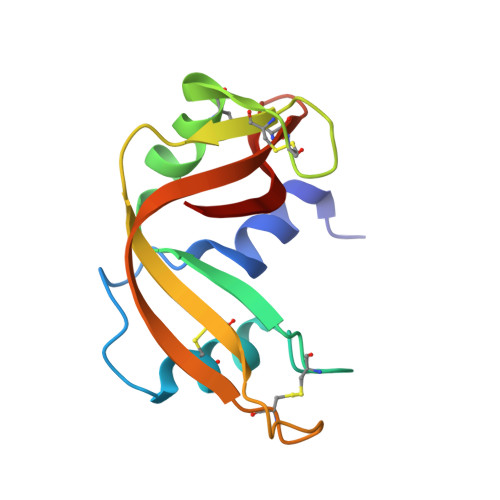Reactions of a tetranuclear Pt-thiosemicarbazone complex with model proteins.
Marzo, T., Navas, F., Cirri, D., Merlino, A., Ferraro, G., Messori, L., Quiroga, A.G.(2018) J Inorg Biochem 181: 11-17
- PubMed: 29353085
- DOI: https://doi.org/10.1016/j.jinorgbio.2018.01.002
- Primary Citation of Related Structures:
5OLD, 5OLE - PubMed Abstract:
The tetranuclear Pt complex (PtL) 4 (where L 2- is the anion derived from para-isopropyl thiosemicarbazone) was first described in A.G. Quiroga et al., J. Med. Chem. 41, 1998, 1399-1408. (PtL) 4 manifests antiproliferative properties toward various cancer cell lines being a promising anticancer drug candidate. Yet, details of its reactivity with biomolecules have not been elucidated. To this end, we investigated the reactions of (PtL) 4 with a few model proteins, i.e. bovine pancreatic ribonuclease (RNase A), cytochrome c (Cyt c) and hen egg white lysozyme (Lysozyme), through electrospray ionization mass spectrometry and other biophysical methods. A rich reactivity of (PtL) 4 with the above-mentioned model proteins is observed, leading to the formation of numerous metallodrug-protein adducts. The tetranuclear complex breaks down and various fragments bind proteins up to high metal/protein ratios; this typically results into very complicated mass spectral patterns. However, some of the main mass peaks could be assigned in the case of the Lysozyme adduct. In addition, crystallographic data were obtained for the (PtL) 4 /Lysozyme and (PtL) 4 /RNase A adducts pointing at His side chains as the primary binding sites for monometallic Pt fragments. Notably, a few selected features of the interactions observed in the (PtL) 4 /protein adducts were reproduced by reacting (PtL) 4 with a small molecule, i.e. N-methylimidazole. In conclusion, the present study confirms the prodrug nature of the tetraplatinum complex, clarifies one possible pathway for its activation through cluster disassembly and allows initial identification of adducts formed with a representative protein.
Organizational Affiliation:
Department of Chemistry and Industrial Chemistry (DCCI), University of Pisa, Via Moruzzi, 13, 56124 Pisa, Italy; Laboratory of Metals in Medicine (MetMed), Department of Chemistry "U. Schiff", University of Florence, Via della Lastruccia 3, 50019 Sesto Fiorentino, Italy.
















